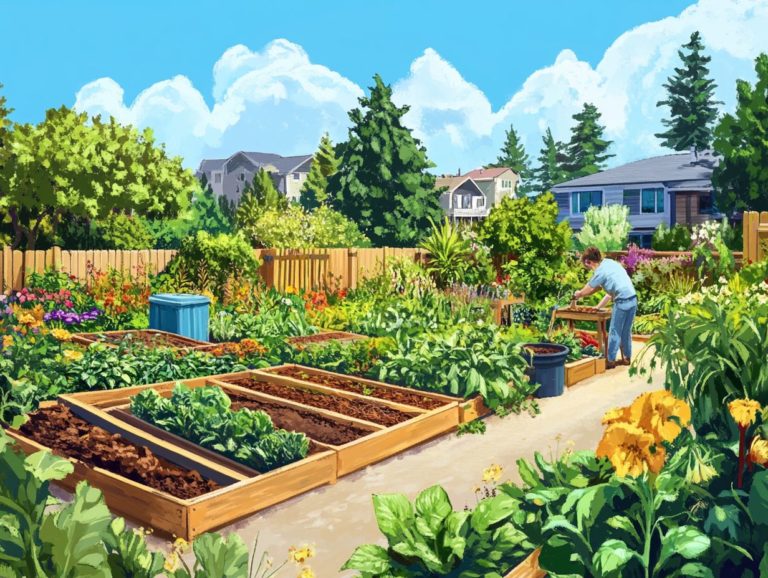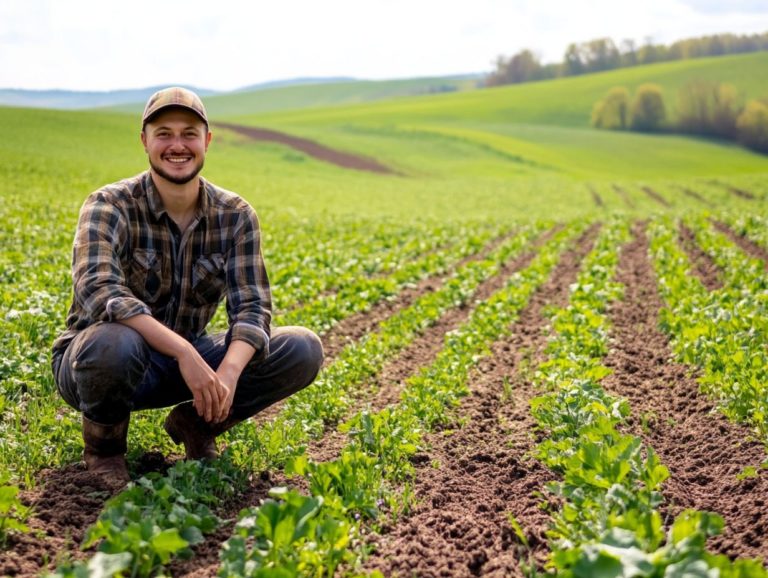What Are the Best Resources for Permaculture Educators?
Permaculture is a transformative approach to sustainable living, especially in community gardening. It s more than just a gardening technique; it s a whole way of thinking about sustainable living that nurtures resilience, fosters community, and promotes environmental stewardship.
This article invites you to explore the essential principles of permaculture education. It highlights the significance of designing systems that not only thrive but also adapt, encouraging community involvement and sustainable practices.
You ll discover valuable resources tailored for educators, including insightful books, comprehensive online courses, and engaging hands-on workshops. You will also learn how to implement permaculture in schools to create meaningful learning experiences that captivate both students and teachers while utilizing community gardens and innovative educational resources.
Jump in now to discover how permaculture can transform your life!
Contents
Key Takeaways:

- Permaculture educators should focus on designing for sustainability and resilience while fostering collaborative learning.
- Books, online courses, and hands-on workshops are valuable resources for deepening knowledge and skills.
- Developing a relevant curriculum that includes hands-on projects is crucial for engaging students and teachers.
What is Permaculture and Why is it Important?
Permaculture invites you to embrace a whole way of thinking about designing sustainable ecosystems. It highlights the intricate connections between natural systems and human needs. Its significance lies in your ability to create resilient communities that can not only endure climate change and resource scarcity but also flourish in their wake.
Through permaculture, you gain practical techniques for self-sufficiency and responsible gardening practices. You cultivate joy and knowledge as you engage with and enhance your environment.
By weaving community involvement and educational initiatives into the fabric of permaculture, you foster a profound sense of belonging and shared responsibility among everyone involved. Workshops, local gatherings, and hands-on projects encourage collaboration, sharing insights, and developing innovative solutions tailored to your unique surroundings.
Permaculture plays a pivotal role in addressing climate challenges by promoting biodiversity, enhancing soil health, and reducing waste. These practices bolster both individual and community resilience, contributing to a broader movement of sustainable living that prioritizes ecological balance and responsible stewardship of our planet for generations to come.
Key Principles of Permaculture Education
The key principles of permaculture education revolve around cultivating a profound understanding of sustainable practices while promoting collaborative learning within your community.
These principles are designed to develop educational resources, including certification courses and workshops that empower you to integrate permaculture into your life and local projects.
Designing for Sustainability and Resilience
Designing for sustainability and resilience in permaculture requires you to utilize techniques that harmonize with natural ecosystems. This ultimately crafts thriving communities and gardens. Through thoughtful planning and resource management, you can foster environments that sustain and amplify biodiversity and self-sufficiency.
For instance, mixing different types of plants can effectively minimize pest outbreaks and enhance soil health, leading to more productive yields. Techniques such as planting certain plants together to help each other grow, mulching, and collecting rainwater for garden use significantly reduce your reliance on external inputs, promoting a balanced ecosystem.
In community gardens, these practices encourage participation and education among local residents, transforming sustainability into a shared ethos. By incorporating structures like compost bins and pollinator gardens, these initiatives tackle food security issues, bolstering resilience in urban landscapes.
Each strategy reinforces the interconnectedness of organisms, creating a robust model for sustainable living that you can be proud to be part of.
Collaborative Learning and Community Building

Collaborative learning and community building are vital elements of permaculture. They allow you to foster connections with others who are passionate about gardening and sustainable practices.
By forming study groups and participating in workshops, you can share resources and experiences that enrich your knowledge and enhance the expertise of your community.
These interactions promote personal growth and cultivate a genuine sense of belonging among members. Local permaculture courses and community gardens show how teamwork sparks innovative solutions to environmental challenges.
For example, workshops focused on composting techniques or rainwater harvesting provide you with hands-on experience and practical skills that you can apply right away.
Study groups can take your learning to the next level! They allow you to dive deeper into specific topics, fostering mentorship and the exchange of ideas. Ultimately, these collaborative efforts enhance learning, making permaculture practices more accessible and effective for everyone involved.
Resources for Permaculture Educators
You’ll find an abundance of resources available for permaculture educators. These span from in-depth books and insightful publications to engaging online courses for permaculture and practical workshops. These materials empower both educators and students, equipping them with essential tools for effectively implementing the basic ideas of permaculture in various settings.
Books and Publications
Books and publications on permaculture are invaluable resources for you as an educator or practitioner. They offer profound insights into sustainable gardening practices and community-building strategies.
These texts cover a broad spectrum of topics, from foundational principles to advanced techniques, significantly enhancing your educational experience.
Noteworthy titles like “The Permaculture Handbook” by Peter Bane and “Gaia s Garden” by Toby Hemenway provide you with a comprehensive framework and practical applications for creating resilient ecosystems. They dive deep into the ethical dimensions of permaculture, emphasizing stewardship of the land and the importance of fostering biodiversity.
In educational settings, these publications can facilitate hands-on learning. They encourage you and your students to apply permaculture principles in your own environments.
Journals such as the “Permaculture Activist” present case studies that illuminate real-world applications. These are perfect for discussions that blend theory with practice, enriching your curriculum and inspiring the next generation of sustainability leaders.
Online Courses and Webinars
Online courses and webinars present you with flexible learning opportunities in permaculture education. They grant access to expert knowledge and a wealth of diverse resources.
Many of these platforms offer certification programs, making it easier for you to establish credibility in sustainable practices.
These formats transcend geographical barriers and accommodate your busy schedule, making them perfect for learners like you.
By engaging with experienced instructors and connecting with like-minded peers, you can gain insights that often elude traditional methods.
Programs such as the Permaculture Design Certificate, available across various online platforms, empower you to apply sustainable techniques in real-world situations.
Resources and materials are frequently updated, ensuring that the courses reflect the latest advancements in permaculture science. This enriches your overall learning experience and equips you with practical skills for implementing eco-friendly practices.
Dive into these resources now and start your journey in permaculture!
Hands-on Workshops and Trainings

Hands-on workshops and training sessions are essential to your permaculture education. They enable you to apply theoretical knowledge in practical contexts. These immersive experiences foster skill development and promote community engagement, deepening your understanding of sustainable practices.
Participating in programs that emphasize hands-on learning, like community garden initiatives and natural building workshops, showcases the transformative impact of this approach. For example, a local permaculture institute recently hosted a series of sessions where you learned to design and implement water management systems. This enhanced your practical skills and facilitated your personal growth. It also strengthened community ties, as you collaborated with others on projects that directly benefited your neighborhood.
As you gained confidence in your abilities, you became an advocate for sustainable living. This created a ripple effect that inspired those around you to explore the possibilities of permaculture.
Adding Permaculture Education in Schools
Adding permaculture education in schools means seamlessly weaving sustainable practices into the curriculum. This creates a rich tapestry of engagement for both students and teachers through various educational tools and resources.
This approach sparks hands-on learning and empowers students to take action as dedicated stewards of their communities and the environment. It fosters a sense of self-sufficiency.
Exciting Curriculum Development and Integration
Exciting curriculum development that brings permaculture education into classrooms is a vital step in nurturing environmental stewardship among students. It ensures they understand the importance of sustainable practices.
By incorporating relevant resources and sustainable practices, you can craft meaningful learning experiences that inspire awareness and provoke action, such as gardening techniques and community projects.
This approach shows the importance of ecological balance and aligns seamlessly with various subjects, from science to art. It enriches the overall educational journey of your students through workshops and gardening courses.
By integrating hands-on activities like school gardens and community gardens, you provide students the opportunity to witness permaculture principles in action. This fosters a deeper understanding of systems thinking seeing how everything is connected and responsible resource management.
Take, for instance, the schools in Vermont that have successfully woven permaculture principles into their curriculum. They showcase innovative techniques and projects that can inspire others. Engaging students in real-world problem-solving and promoting biodiversity on campus through experimental gardening and study groups exemplifies the harmonious relationship between education and sustainability.
How can you make a difference in your own neighborhood? Such initiatives set the stage for future generations to adopt environmentally friendly practices in their personal and professional lives.
Engaging Students and Teachers
Engaging students and teachers in permaculture education is essential. It cultivates sustainability in schools and boosts community involvement.
This involvement deepens their understanding of ecological principles. It also nurtures a sense of responsibility toward the environment, fostering joy and fascination for nature.
By utilizing hands-on learning opportunities like interactive workshops, outdoor classrooms, and collaborating with local permaculture experts, you can create an exciting environment that inspires everyone!
Using digital resources like online courses and virtual garden designs caters to diverse learning styles. This ensures that every participant has the opportunity to contribute to shared permaculture projects.
The ripple effect of such engagement can significantly strengthen community ties. It can lead to collaborative projects that further advance environmental stewardship through initiatives like Food Not Lawns.
Frequently Asked Questions

What is permaculture?
Permaculture is a holistic design system for sustainable living. It incorporates principles and practices from ecology, agriculture, and social systems, emphasizing survival skills and self-sufficiency.
What are the best resources for permaculture educators?
1990 is a comprehensive database of resources specifically curated for permaculture educators. It includes books, articles, videos, and online courses, including a certification course for those interested in furthering their knowledge.
What types of resources are included in 1990?
1990 includes a wide range of resources such as instructional materials, lesson plans, case studies, and research articles. These help educators teach permaculture principles effectively.
Are there any online courses available on 1990?
Yes, 1990 offers a variety of online courses from experienced permaculture educators. These include the Permaculture Design Certificate (PDC) and other specialized gardening courses.
These courses cover topics like design principles, organic gardening, and community building, offering various techniques and tools for practical implementation.
Can I contribute to 1990 as a permaculture educator?
Absolutely! 1990 is a community-driven resource, and we welcome contributions from permaculture educators. You can share your publications, blogs, lesson plans, videos, and other materials to help enrich the database.
How can I access 1990?
You can access 1990 by visiting our website at www.1990.com. There, you can also find links to great Facebook groups. Follow us on social media like Facebook to stay updated on new resources and community discussions related to permaculture education.
Visit our website today to start your permaculture journey!






